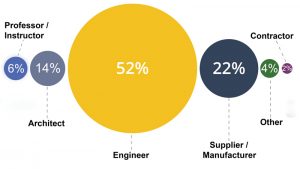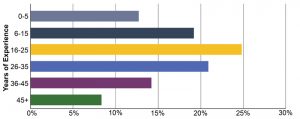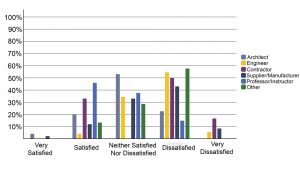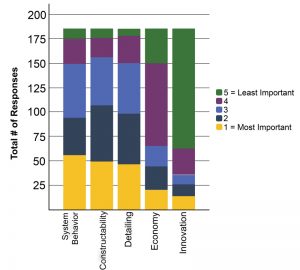The author’s “Masonry Education Survey,” administered in October 2018, sought to answer two overarching questions: 1) are industry practitioners satisfied with the masonry design knowledge that graduating structural engineers bring with them into the workforce, and 2) what aspects of masonry design are most important for graduating structural engineers to master. This survey elicited passionate responses from engineers, architects, contractors, suppliers, instructors, and industry representatives involved in the design, specifying, installation, and/or manufacturing of masonry systems for buildings. This article expands on material previously presented at the 13th North American Masonry Conference, with additional survey results gathered through September 2019.
Industry Survey & Respondent Demographics
A total of 237 individuals voluntarily took a nine-question online survey in response to an open invitation circulated by the Masonry Society, the Pennsylvania Concrete Masonry Association, the Mid-Atlantic Masonry Association, the Northwest Concrete Masonry Association, the International Masonry Institute, and word-of-mouth. 185 respondents completed all required questions, and 31 completed the ninth optional comment question. Participant attrition increased quadratically up to 8% at question six, topping out at 21.9% for question seven – an improvement over preliminary survey responses wherein a reduced percentage completed the survey.
More than half of the respondents were engineers, a quarter were suppliers/manufacturers, and the remaining were a mix of architects, professors/instructors, contractors, and industry representatives (Figure 1). Sixty-eight percent of the respondents had more than 16 years of experience, with 8.3% having more than 45 years of experience (Figure 2). Respondents worked on projects across the continental United States, distributed as shown in Figure 3.
Satisfaction Ratings

Figure 4. Overall rating of satisfaction with the level of masonry knowledge in graduating engineers.
Participants rated their level of satisfaction with new engineers’ level of masonry knowledge upon entering the workforce. Forty-six percent of respondents indicated that they are dissatisfied, 6% were very dissatisfied, 36% were neither satisfied nor dissatisfied, and 11% were satisfied. Only 1% indicated that they were very satisfied. Figure 4 depicts overall satisfaction ratings for the entire group of respondents, while Figure 5 breaks out the satisfaction ratings by discipline. Generally, engineers and suppliers/manufacturers were “dissatisfied” while professors/instructors were “satisfied.” Contractor opinion was bimodal but weighted more heavily towards “dissatisfied.” Architects’ opinions were more balanced, centered on “neither satisfied nor dissatisfied.”
When asked whether topics beyond basic member design should be included in masonry engineering courses, 93% said “yes.” Most comments on this question were positive, encouraging the inclusion of topics such as constructability, economy, understanding masonry as a system, arching action, control joints, fire safety, detailing, and durability. However, many remarked on the complete absence of masonry courses in engineering curricula, or the lack of technical depth provided in existing masonry courses. Several respondents cautioned against reducing class time spent on steel and concrete design in favor of including more masonry, but still supported that masonry should be taught to engineering students.
Topic Rankings and Results
Respondents weighed in on which topics should be included in the ideal masonry course, ranking five general topic areas on an importance scale from 1 (most important) to 5 (least important). Figure 6 displays these results in descending order of ranked importance from left to right. There is insufficient space within this article to address the many generous comments received from survey respondents. Below is the author’s ‘highlight summary’ that encapsulates the most common comments and respondent suggestions, in condensed form:
System Behavior
Understanding masonry as a system of modular elements is most important, relating to how masonry is similar to but also different from other materials. Topics such as arching action, thermal expansion, historical masonry behavior (e.g., flying buttresses), the effect of control joints on wall behavior and lateral stiffness, veneer, wall systems, and how masonry can work together with architecture – not against it – should be included. Teaching engineered masonry also reinforces the fundamental engineering mechanics skills that students need, without emphasis on prescriptive code compliance.
Constructability
“Passionate” is the best way to describe respondent comments regarding constructability. Engineers, especially new engineers, need to understand how masonry systems are constructed to avoid costly schedule delays, increased labor costs, and increased material waste. The industry strongly recommends hands-on field experience before designing, specifying, or detailing masonry systems. This would result in reduced field cutting of blocks, improved cell space for grout consolidation at rebar laps, more constructible attachments, and reduced installation difficulty.
Detailing and Economy
Economy follows good detailing that leads to constructible masonry solutions. Understanding the modularity of masonry and why it is selected as an economical material is vital. Physical limitations for placing reinforcement, crack control with appropriately detailed joints, familiarity with cast-in and post-installed anchors, and the effect of air spaces in cavity walls on anchorage to masonry is also essential. While engineers typically do not specify waterproofing, flashing, weeps, etc., an understanding of these issues is essential to good detailing.
Innovation
Engineers need to stay abreast of new technologies and developments related to masonry; however, this was ranked less important than the other categories. Several respondents cited the use of the ASTM C-90 minimum f´m of 2,000 psi, instead of the previous 1,500 psi, as an example of missed innovation opportunity. While limited class time should be spent on innovative technologies, graduating engineers may be expected to be more familiar with newer technologies. They should be prepared to critically review and introduce innovative concepts to their more experienced colleagues.
Industry Wishes
This survey revealed that the masonry industry would like to see graduating engineers who: 1) have successfully completed a course in masonry – with an emphasis on system behavior, constructability, and detailing of masonry structures, 2) have had hands-on experience with masonry installations, and 3) strategically leverage masonry for economy and simplicity on projects. Instructors are encouraged to attend a Masonry Educators Workshop (MEW) and contact The Masonry Society (TMS) for support as they develop masonry content for their courses.■





